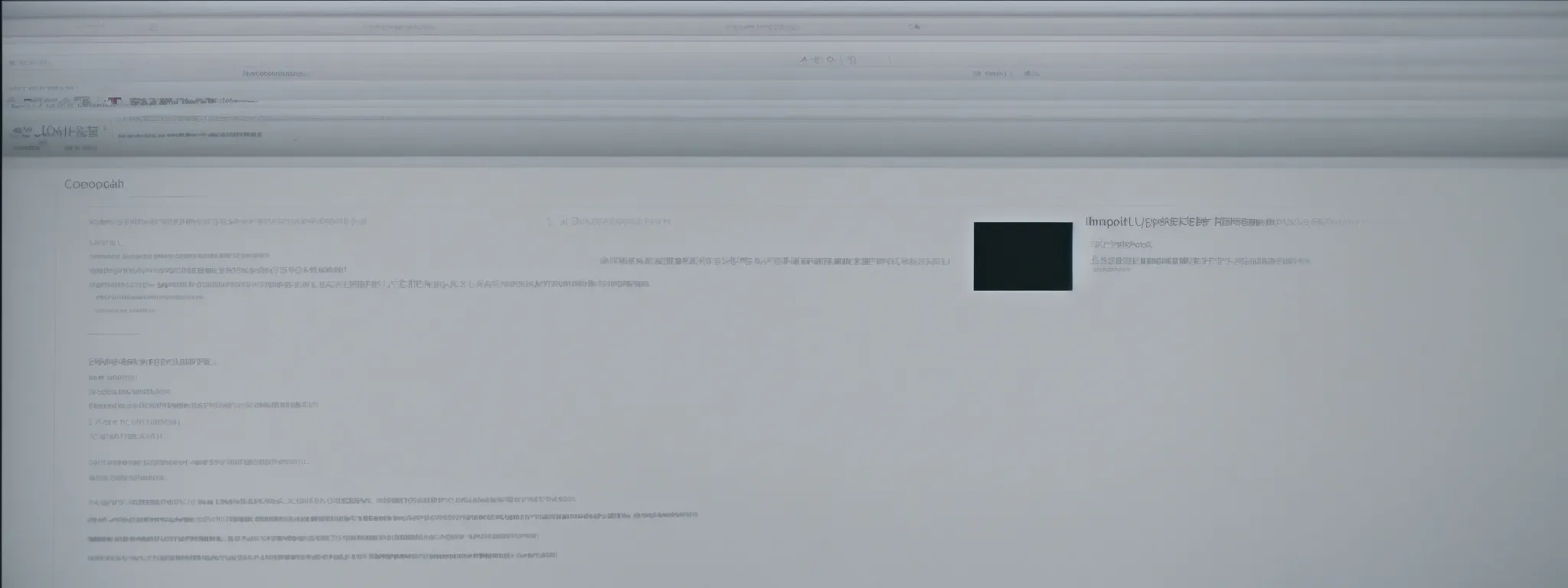Maximizing SEO Impact with Internal Linking
Boosting Your SEO: The Power of Strategic Internal Linking Internal links are not merely navigational tools; they wield significant influence over a website’s SEO fortitude. By establishing […]
Boosting Your SEO: The Power of Strategic Internal Linking
Internal links are not merely navigational tools; they wield significant influence over a website’s SEO fortitude.
By establishing a sound internal linking strategy, website owners can effectively guide both users and search engines through their site’s content, improving both indexability and user experience.
Strategic anchor text selection and link placements can distribute link equity throughout a site, enhancing the visibility and authority of key pages.
With meticulous planning, internal links can transform a silent website structure into a resonant echo chamber that amplifies a site’s relevance and ranking power.
Keep reading to unlock the potential of internal links in bolstering your site’s SEO performance.
Key Takeaways
- Internal Linking Is a Pivotal Strategy for Distributing Link Equity and Enhancing Page Authority
- Strategic Internal Linking Can Enhance Site Navigation, Improve User Experience, and Augment SEO Performance
- LinkGraph’s SEO Services Leverage Internal Linking to Ensure Site Content Is Indexed Effectively, Increasing Search Visibility
- Precise Use of Varied and Descriptive Anchor Text in Internal Links Helps Avoid Over-Optimization Penalties
- LinkGraph Employs Internal Linking Techniques to Transfer Authority to Underperforming Pages, Improving Their SERP Rankings
Understanding the Role of Internal Links in SEO

In the intricate tapestry of Search Engine Optimization, internal linking emerges as an essential strategy for webmasters and SEO professionals.
This technique, fundamental to the structuring of website pages, serves to channel link equity throughout a site and acts as a guide for both search engine crawlers and visitors.
Unlike outbound links that lead a user to a different domain, internal links create a cohesive network within a website, allowing both users and search engines to navigate with ease.
Thus, grasp of internal linking is paramount to enhancing a site’s SEO performance, securing a robust online presence that leverages LinkGraph’s expert on-page SEO services and diverse tools like SearchAtlas SEO software.
Explaining the Basics of Internal Linking
Internal linking refers to the Array of Hyperlinks that connect various pages on the same website. These navigational aids are vitally important as they not only help users discover information seamlessly but also aid search engines in indexing site content effectively.
Strategically placed internal links enhance the relevancy and authority of a page by distributing ‘link juice’—a term used to describe the value passed from one page to another. This distribution of link equity can markedly improve page authority and has a direct impact on a webpage’s ranking in search engine results pages (SERPs):
| SEO Component | Role in Internal Linking | Impact on Web Page |
|---|---|---|
| Link Juice | Value Distribution | Enhances Page Authority |
| Page Authority | Boosted by Internal Links | Improved SERP Positioning |
| User Navigation | Guided by Link Structure | Improved User Experience |
How Internal Links Differ From Outbound Links
Internal links are the connective tissue that holds a website’s structure together, distinctly different from outbound links that act as bridges to other domains. Whereas outbound links endorse external content and can contribute to a site’s authority from an external perspective, internal links foster a site’s own ecosystem, strengthening the interconnectivity of content within the same domain.
The synergistic effect of internal links propels a unique advantage: the ability to orchestrate the flow of link juice directly within the control of the website owner. By comparison, outbound links relinquish some degree of that control, casting link equity outward and, in turn, bolstering the relevance and authority of external pages.
| Link Type | Site Impact | SEO Influence |
|---|---|---|
| Internal Links | Consolidates Site Content | Directs Link Equity Internally |
| Outbound Links | Connects to External Sites | Shares Authority Externally |
Crafting a Robust Internal Linking Structure

Embarking on the journey of elevating a website’s search engine visibility begins with a carefully crafted site architecture.
While akin to the foundation of a building, establishing an intuitive and SEO-friendly site structure necessitates methodical planning and insightful foresight.
Experts, through the lens of best practices in Search Engine Optimization, concentrate on orchestrating a site hierarchy that is both user-centric and search engine friendly.
At the heart of this endeavor lies the meticulous identification of main content categories and the establishment of targeted linking strategies.
These steps ensure that every hyperlink serves a strategic purpose, strengthening the website’s overarching link ecosystem and bolstering its performance in the eyes of both visitors and search engines alike.
Planning Your Site’s Hierarchy With SEO in Mind
Developing a site hierarchy is an elemental step in creating an SEO-optimized website that caters to both search algorithms and user needs. LinkGraph’s SEO experts emphasize the significance of a logical site structure that intuitively categorizes content, allowing for a smoother user journey and efficient crawling by search engines, which can eventually amplify search traffic and boost rankings.
Central to this strategy is the arrangement of category pages as cornerstones of the site’s infrastructure, underpinned by a network of internal links that not only enhance navigability but also concentrate link equity in a manner designed to maximize SEO benefits. LinkGraph’s SEO services offer Tailored Assistance in this vital planning stage, ensuring the foundation laid down will support robust internal linking capable of achieving desired SEO outcomes.
Identifying Main Content Categories for Targeted Linking
In a concerted effort to optimize a website’s visibility and user engagement, identifying main content categories stands as a central strategy. LinkGraph’s meticulous approach to SEO includes discerning the major thematic pillars around which a site’s content revolves, facilitating targeted internal linking that reinforces the topical strength and authority of those categories.
Fostering a coherent content strategy begins with pinpointing the pivotal pages that exhibit the potential to become pillar pages. These serve as the gravitational centers for related content, ensuring that internal linking aligns with user intent and enhances the website’s SEO footprint:
| Content Pillar | Related Content | Internal Linking Role |
|---|---|---|
| Pillar Page | Subtopics and Supporting Pages | Anchor for Topical Authority |
| Category Page | Product or Service Listings | Facilitate Navigability and Relevance |
| Blog Post | Additional Reading and Insights | Drive Engagement and Extend Session Duration |
By aligning a website’s internal linking strategy with its content hierarchy, LinkGraph’s SEO services ensure the allocation of link equity is both deliberate and beneficial. It is this harmonic integration of content with strategic linking that can significantly lift a site’s prestige and relevance in the SERPs, ultimately enhancing visibility and driving organic growth.
The Importance of Anchor Text in Internal Linking

In the refined landscape of Search Engine Optimization, the strategic application of anchor text within internal links garners significant attention for its potential to strengthen a website’s SEO performance.
Effective anchor text selection is critical, providing context to both users and search engines about the destination page, thereby enhancing the SEO benefits.
Key considerations involve crafting descriptive, non-generic anchor text while ensuring variation to sidestep over-optimization penalties.
This precise maneuvering through the anchor text domain underscores the expertise inherent in LinkGraph’s SEO services, which adeptly balance keyword-rich phrases with diversity to foster a healthy, authoritative website profile.
Choosing Effective Anchor Text for SEO Benefits
When it comes to utilizing anchor text within internal linking, precision remains key. The chosen text must accurately reflect the content of the destination page, thus signaling to search engines the relevancy and context of the linked resource. LinkGraph’s SEO professionals advocate the use of succinct, context-rich anchor texts which serve dual purposes: guiding users effectively and optimizing the pages for targeted search queries.
Reflecting the significance of diversification, LinkGraph’s SEO strategy advises against repetitive anchor text, which can trigger search engine algorithms to flag a website for spammy practices. The team meticulously develops anchor text that aligns with an evolving SEO content strategy, ensuring that each link contributes to a coherent narrative on the website, elevating its authority and supporting the overarching SEO efforts with finesse.
Avoiding Over-Optimization Penalties With Varied Anchor Texts
Navigating the treacherous waters of SEO requires a subtle balance, particularly when employing anchor texts to avoid over-optimization penalties. LinkGraph’s SEO echelon addresses this by orchestrating a variety of descriptive phrases, carefully calibrated to mirror the content they point to without undue repetition.
This strategic patterning of anchor texts mitigates the risks of attracting punitive action from search engines, which can misconstrue excessive identical anchor texts as manipulative attempts to game the system. LinkGraph’s SEO acumen ensures that each hyperlink not only serves its navigational purpose but also contributes holistically to the site’s reputable SEO standing.
Boost Your Site’s Indexability With Strategic Link Placement

Digital landscapes are constantly evolving, and maintaining agility within these terrains is critical for businesses aiming to secure and enhance their online presence.
Site indexability can significantly impact how swiftly a webpage surfaces on search engines—pivotal for staying visible and relevant.
Leveraging LinkGraph’s comprehensive suite of SEO services, which include innovative linking strategies and advanced indexing tactics, organizations can ensure their new and existing pages are discovered and valued by search engines.
The adoption of sound linking strategies promises not only improved crawlability but also expedites the indexing process for new pages, cementing a website’s position in the competitive realm of search engine results.
Linking Strategies to Improve Crawlability for Search Engines
Strategic Internal Linking is a cornerstone for bolstering a website’s SEO, and it begins with mindful placement of links that facilitates search engines’ ability to crawl and index content efficiently. By integrating strategic links that interconnect pivotal pages, such as category pages and pillar content, LinkGraph enables a thorough exploration of a site by search engine bots, simplifying the process of indexing and ensuring that key pages gain the visibility they merit.
LinkGraph’s approach to enhancing crawlability goes beyond mere link placement; it involves a meticulous analysis of site architecture to streamline navigation for search engine crawlers. By systematically linking to important yet potentially overlooked pages, such as deep-seated informative articles or cornerstone product pages, LinkGraph’s SEO services promote thorough indexing, which is vital for achieving a comprehensive digital footprint on search engines.
Advanced Tactics to Get Your New Pages Indexed Quickly
To accelerate the indexing of new pages, LinkGraph harnesses the prowess of their Cutting-Edge SearchAtlas SEO Software. This innovative tool adeptly streamlines indexation by signaling to search engines the presence of fresh content, ensuring prompt attention and swift indexing.
Moreover, the strategic deployment of internal links from high-traffic pages to new content amplifies visibility, urging search engine algorithms to prioritize the discovery of these updates. LinkGraph’s tactical expertise in SEO facilitates not only the expeditious indexing of new pages but also enhances their potential to climb in SERP rankings.
Enhancing User Experience Through Internal Links

Within the landscape of search engine optimization, the intricacies of site navigation and user retention are deeply influenced by the strategic deployment of internal links.
Well-executed internal linking not only simplifies navigation by creating a logical pathway through a website but also plays a pivotal role in holding visitor attention, reducing bounce rates, and encouraging a deeper engagement with the site’s content.
By carefully integrating internal links, websites craft a user experience that intuitively guides visitors from initial interest to decisive conversion points, underpinned by LinkGraph’s expertise in sculpting a site structure conducive to both user satisfaction and SEO enhancement.
How Proper Linking Aids in Site Navigation and User Retention
Proper deployment of internal links is a linchpin in creating an intuitive navigation system that effortlessly guides users from one piece of content to the next, fostering a seamless user journey. By implementing a considered linking strategy, LinkGraph’s on-page SEO services ensure that visitors are subtly directed to key areas of a website, thereby reducing confusion and the likelihood of premature departures.
Moreover, strategic internal linking enhances user retention by providing pathways to additional relevant content, keeping visitors engaged and interacting with the site for longer periods. LinkGraph’s nuanced understanding of user behavior and SEO best practices empowers businesses to craft a web of links that nurture a user’s curiosity and encourage a deeper exploration of the site’s offerings.
Using Internal Links to Guide Visitors Toward Conversion Points
LinkGraph’s diligent application of internal linking serves as a highly effective funnel, smoothly directing visitors towards the most valuable conversion points within a website. By strategically placing links in content where users are most engaged, these navigational cues subtly encourage further interaction, eventually leading to increased conversion rates.
Intuitive internal link placement by LinkGraph experts acts as silent beacons amidst content, guiding users to areas that bolster business objectives, whether it be filling out a contact form, signing up for a newsletter, or making a purchase. This strategic design in linking ensures that potential customers are merely a click away from taking desired actions, enhancing the efficacy of the sales funnel.
Leveraging Internal Links to Spread Page Authority

In the dynamic realm of SEO, strategic internal linking proves instrumental in amplifying a website’s influence and prominence in SERPs.
The judicious distribution of link equity across a site’s web pages is akin to distributing power within a network, invigorating pages with the potential to climb search engine rankings.
Techniques that refine the spread of this influence are essential for bolstering the authority of underperforming pages, transforming them into robust contenders that capture and retain organic traffic.
It is within this context that LinkGraph’s SEO services shine, offering expert guidance and advanced tools to master the distribution of page authority through effective internal linking strategies.
Understanding the Distribution of Link Equity Across Pages
In the multifaceted world of SEO, understanding the nuances of link equity distribution is vital for amplifying a page’s authority. Each internal link within a website carries a portion of link equity, a key element that can elevate a page’s status in the eyes of search engines: this process is instrumental in ensuring that valuable link equity is not concentrated on a few pages but is dispersed across the site to bolster the entire domain’s authority.
LinkGraph’s strategic approach to internal linking ensures the equitable dispersion of link equity, elevating pages that are critical to a site’s SEO strategy. This meticulous allocation of link value supports underutilized pages and raises the overall SEO profile of the site, leading to enhanced visibility and higher SERP rankings:
| SEO Task | Internal Link Function | Resultant Action on Page Authority |
|---|---|---|
| Link Equity Distribution | Connectivity Within Site | Even Spread of Authority |
| SEO Profile Enhancement | Strategic Link Placement | Increased Visibility and Rankings |
Techniques for Boosting the Authority of Underperforming Pages
To revitalize underperforming pages, LinkGraph’s SEO connoisseurs employ a nuanced internal linking strategy that targets these weaker sections with links from higher-performing pages. Identifying pages that already garner significant attention and linking from these to less visible content effectively transfers some of the established authority and improves the underperforming pages’ potential to rank higher.
Another technique within LinkGraph’s suite of SEO strategies focuses on optimizing the anchor text for links leading to underperforming pages. Careful crafting of descriptive, keyword-rich but varied anchor text signals the importance and relevance of the content, compelling search engines to reassess and elevate the standing of these pages in search results.
Conclusion
Strategic internal linking is a crucial component in bolstering your website’s SEO performance.
By creating a coherent network of links within your site, you direct link equity, enhance page authority, and improve your SERP positioning, all of which are paramount for securing a robust online presence.
Thoughtfully structured internal links enable search engines to index your site efficiently, while aiding user navigation and retention by providing a seamless experience and guiding visitors toward conversion points.
Moreover, internal linking allows the spread of authority to underperforming pages, lifting their visibility and organic reach.
Implementing a well-planned internal linking strategy with LinkGraph’s SEO services ensures that your site maintains a competitive edge in the digital landscape, enhancing both user satisfaction and search engine rankings.















































































